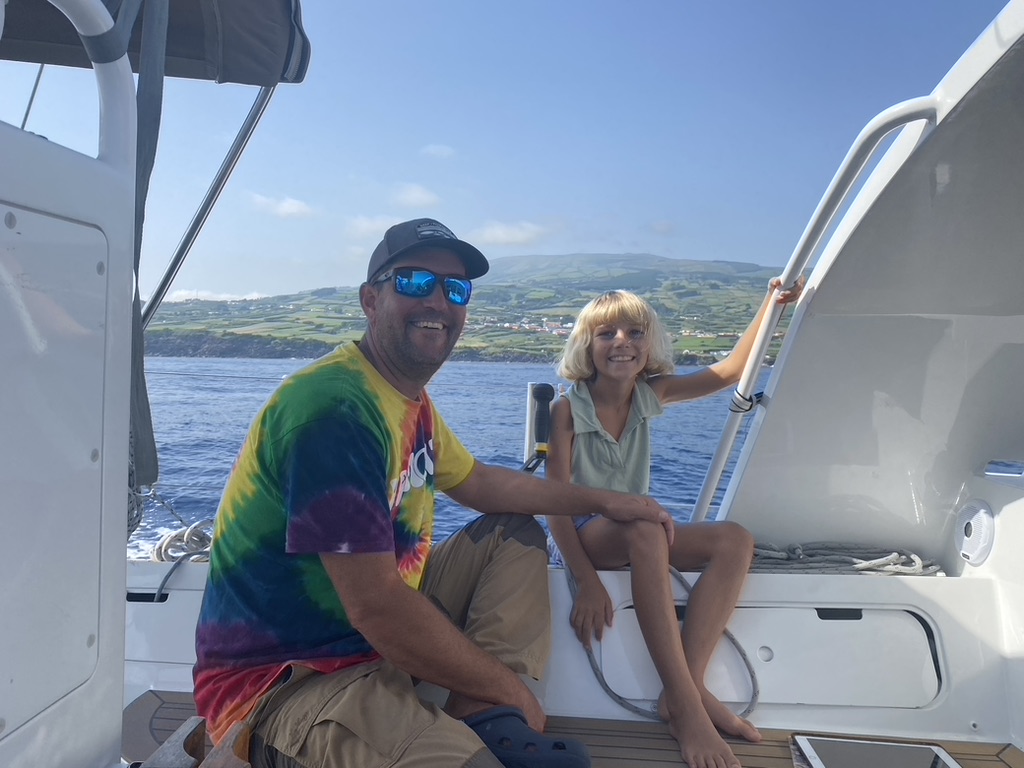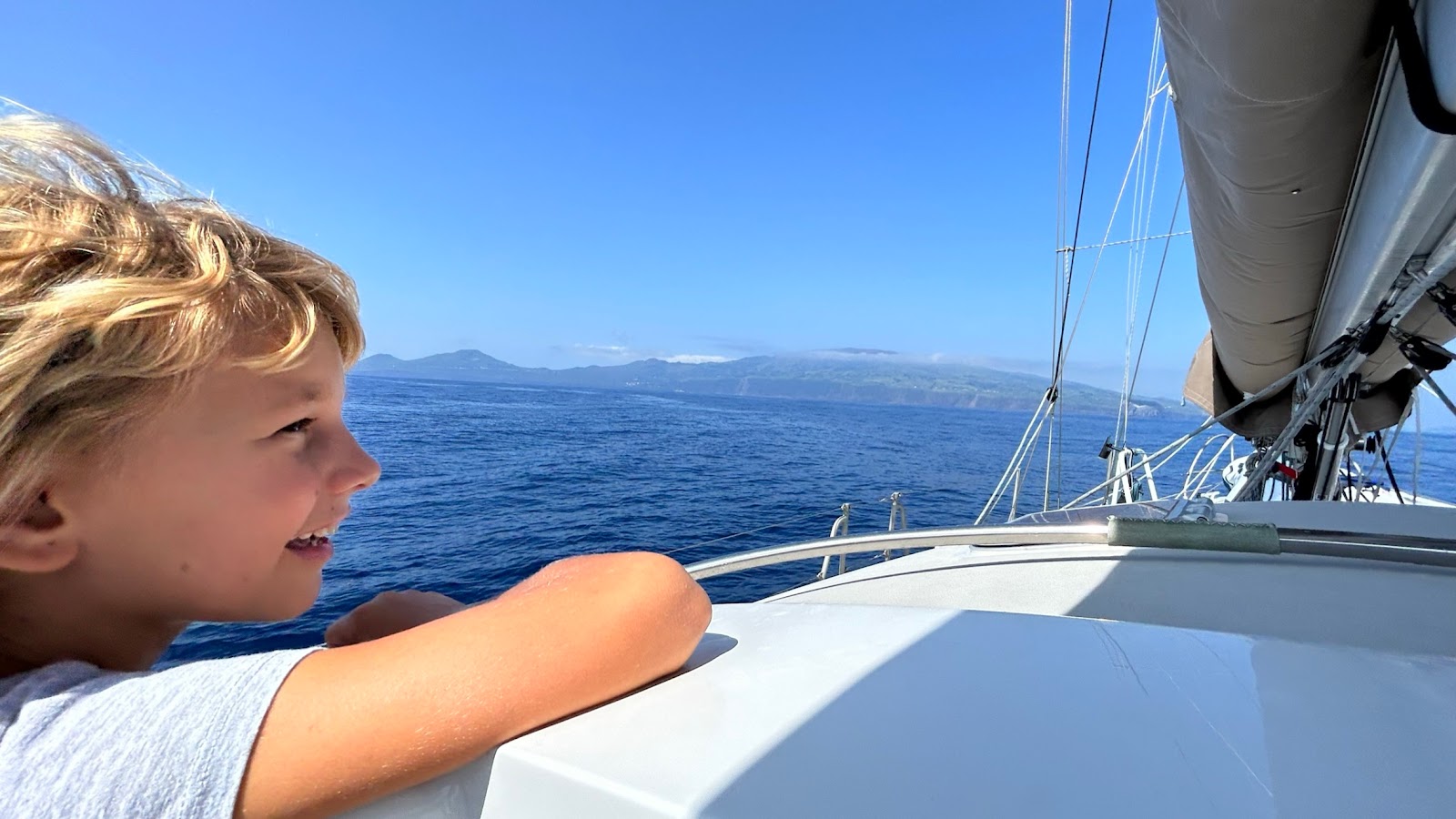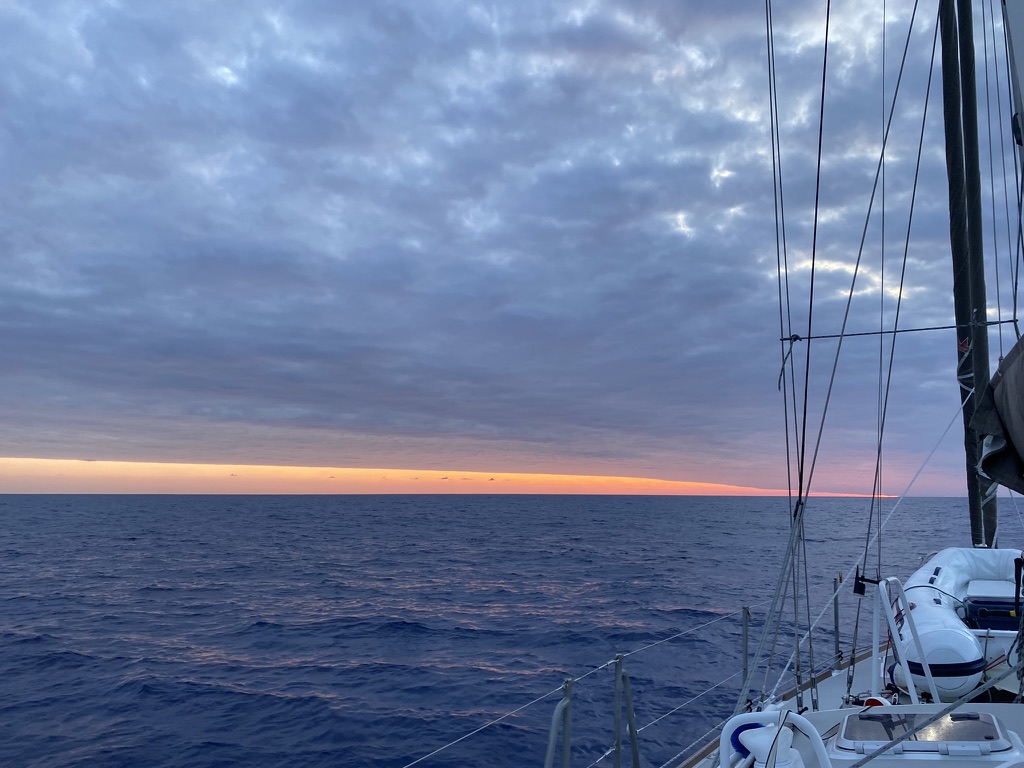 |
Day 1 (or 2) of Bahamas to Bermuda. Feeling icky and trying to be as comfortable as possible.
|
 |
Freja's perspective.
|
 |
A day of respite--no wind, so motoring, but also calm and a nice sunset dinner in the cockpit.
It was really nice to take a break.
|
 |
Clapping games in the cockpit on a calm day.
|
Objectively speaking, they were tough passages. It was windy—sustained winds at over 30 knots for days, and the seas were big. The wind was forward of the beam from the Bahamas to Bermuda, so we were constantly heeled over 15-20 degrees and everything was salty. Our bodies were tired and ached. The winds were mainly from behind for the second third of our passage from Bermuda to the Azores, but we had days of 30+ knots and 3-4 meter seas. Again, salty, tired, and achey bodies. These passages were a frank reminder that sailing is indeed a sport—one that requires physical strength and conditioning.
More importantly, long distance sailing requires mental stamina. Ocean passages are mental and physical endurance challenges and if you’re not committed and positive, it’ll be a long haul. To risk sounding too much like a cliche, my head just wasn’t in the game. The sailing was hard, but it felt more difficult than it actually was; I was not having a good time. In retrospect I realize that I saw both passages as a means to an end—sailing in order to travel rather than sailing with the bonus of arriving in a new place to explore. It takes a long time to cross an ocean in a small sailboat and being overly focused on the destination rather than the passage is a surefire way to have a long, hard passage.
 |
We rationed the last season of Jane the Virgin so we could watch two episodes a night. Definitely a highlight of the passage (except when it was over).
|
 |
Arrival in Bermuda and sharing the channel with a cruise ship.
|
I’m not sure what I was expecting. I knew they wouldn’t be the flat tradewind sailing of our east to west transAtlantic, but I guess I hadn’t fully prepared myself for the reality of multiple days to windward with big swells. My emotions ranged from frustrated, to annoyed, to angry, to fed-up, and, even though I wasn’t feeling it, I had to work hard to put on a good face for the kids. Emotions intensify at sea and one bad mood can easily over-power the best of moods, so it was important that I at least tried to be cheery, even if it was forced cheer.
 |
Forced cheer at least makes for a good photo.
|
Why so miserable? We’d had it easy until this point—short day sails with benign conditions, and our biggest passage to date was with the tradewinds—so I think my expectations were off. Can I blame social media?! We always hear how social media can be detrimental to self-esteem, especially among teenagers, because it’s so easy to compare yourself to images you see on Instagram. Perhaps the same holds true for sailing. There are so many sailing vloggers and instagrammers that make ocean passages look so…glamourous. And peaceful. And one with nature. So, despite my years and miles of experience on the water, my expectations got a little skewed. When I’m uncomfortable and frustrated and basically not having fun, it feels so much worse because, perhaps after one too many instagram scrolls, there is a little voice in my head that says that ocean passages should be all dolphins and star gazing and perfect cups of tea to start a night watch. Yeah, not so much. Add in seasickness, salt, smelly bodies, tired muscles, and the absolute difficulty in trying to pull your pants off (and then up again) just to use the toilet.
And I’m not done! In addition to skewed expectations, insert the undercurrent of fear. A certain level of fear is vital for an ocean passage. It can’t paralyze you, but there has to be enough fear to keep you on your toes—remember to clip on your tether before leaving the cockpit, always hold on in case the boat suddenly gets pushed by a wave, and constantly have an eye on the kids when they’re outside. But that steady pulse of fear (or we could be generous and call it awareness) gets exhausting after a week or so
 |
Hans and Matilda making lures on the back deck.
|
 |
Freja spent the whole passage from Bermuda to the Azores, 11 days, relaxing/trying to be comfortable down below since she was very limited due to her broken wrist.
|
 |
Squally weather on night watch. I watched Casablanca for the first time since Screen Studies 101 in college. A great movie.
|
 |
Squally, windy weather.
|
 |
Land ho! One of our most epic landfalls to date.
|



We still have around 1,000 nautical miles, about one week of sailing, to get to the European mainland. So how do I turn this negative headspace around and have a more successful passage? How can I start to feel good about it, even look forward to it so I can have a much better experience? Start to focus on the positive waves…
The first obvious positive: our boat can handle it. While these two passages may have been difficult for me, they were chump change for the Boreal. And thank goodness for that. In my worst moods, in my most uncomfortable state of being, I was able to look around and say, well, at least the boat is doing fine.
The second obvious positive: We had so much pre-made food that we didn’t have to really cook. At most we boiled spaghetti. Usually we grabbed a bag of something frozen, let it defrost all day, and heated it on the stove for dinner.
The third positive (that I’ll never take for granted): the kids didn’t complain. Ok maybe they complained a little. But they just got comfortable, dug in, and passed the days watching Netflix, playing games on their tablets, and listening to audiobooks.
 |
We gave the kids passage presents every 300 miles or so.
Wikisticks were a hit and they had fun with food competitions.
|
That’s what I have for positives. What will I actively do to have a better passage from the Azores to mainland Europe?
- Be in better physical shape before we leave.
- Take seasickness meds sooner and more frequently;
- Look for a forecast of 10-15 knots of wind as opposed to 15-20. (Our actual winds were consistently 10 knots higher than forecast.)
- Download funny audiobooks and podcasts.
- Wrap my head around the idea that sailing is a sport.
- Prepare myself for discomfort, but know that it is short-lived and can be fun.
- Remember that life on passage will be different than life at anchor. We will be dirty and salty and dishes may pile up. It’s ok.
- Remember the sense of accomplishment and achievement I always feel when we reach port.
 |
Sunrise en route to the Azores.
|
When Hans and I first went sailing for an extended period of time, on our Albin Vega Whisper, we started the trip not really knowing how to sail and just sailing to travel. After three years on the water, I almost liked the sailing more than the traveling. I went from dreading night watches to looking forward to the star gazing. I did a little solo sailing from Culebra to mainland Puerto Rico. And I felt this deep, inner satisfaction that I could cross oceans in my small sailboat with confidence. My goal for the last leg of our current Atlantic crossing is to get that satisfaction back—to not just grin and bear it but to actually enjoy the passage, or at least feel good about the passage. Because after all, if I’m not enjoying the sailing, why are we doing all the hard work of living on the boat?























Comments
Post a Comment